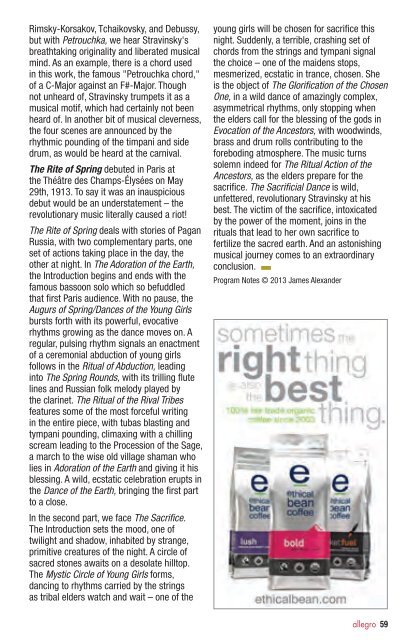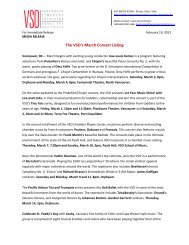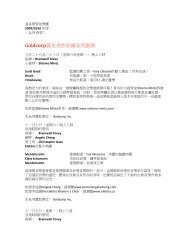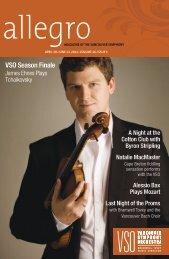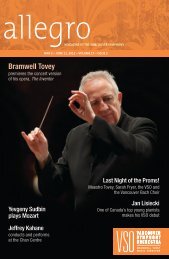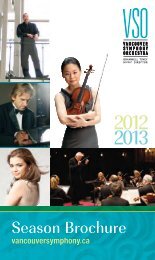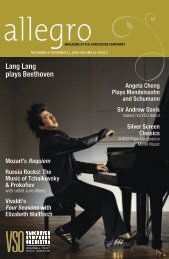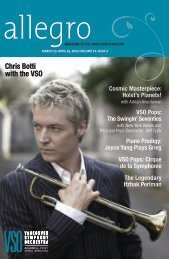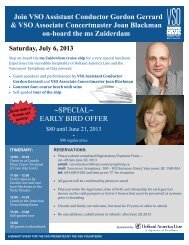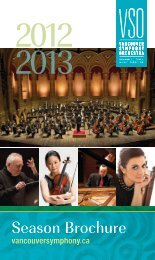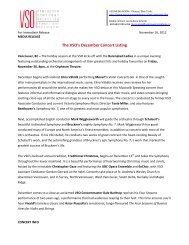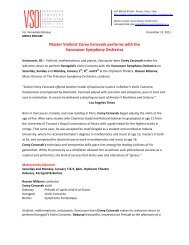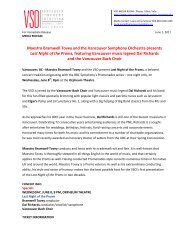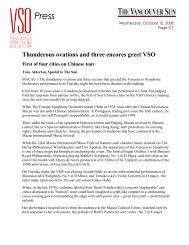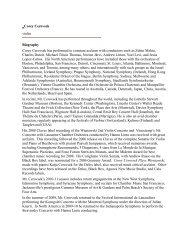issue five - Vancouver Symphony Orchestra
issue five - Vancouver Symphony Orchestra
issue five - Vancouver Symphony Orchestra
Create successful ePaper yourself
Turn your PDF publications into a flip-book with our unique Google optimized e-Paper software.
Rimsky-Korsakov, Tchaikovsky, and Debussy,<br />
but with Petrouchka, we hear Stravinsky's<br />
breathtaking originality and liberated musical<br />
mind. As an example, there is a chord used<br />
in this work, the famous "Petrouchka chord,"<br />
of a C-Major against an F#-Major. Though<br />
not unheard of, Stravinsky trumpets it as a<br />
musical motif, which had certainly not been<br />
heard of. In another bit of musical cleverness,<br />
the four scenes are announced by the<br />
rhythmic pounding of the timpani and side<br />
drum, as would be heard at the carnival.<br />
The Rite of Spring debuted in Paris at<br />
the Théâtre des Champs-Élysées on May<br />
29th, 1913. To say it was an inauspicious<br />
debut would be an understatement – the<br />
revolutionary music literally caused a riot!<br />
The Rite of Spring deals with stories of Pagan<br />
Russia, with two complementary parts, one<br />
set of actions taking place in the day, the<br />
other at night. In The Adoration of the Earth,<br />
the Introduction begins and ends with the<br />
famous bassoon solo which so befuddled<br />
that first Paris audience. With no pause, the<br />
Augurs of Spring/Dances of the Young Girls<br />
bursts forth with its powerful, evocative<br />
rhythms growing as the dance moves on. A<br />
regular, pulsing rhythm signals an enactment<br />
of a ceremonial abduction of young girls<br />
follows in the Ritual of Abduction, leading<br />
into The Spring Rounds, with its trilling flute<br />
lines and Russian folk melody played by<br />
the clarinet. The Ritual of the Rival Tribes<br />
features some of the most forceful writing<br />
in the entire piece, with tubas blasting and<br />
tympani pounding, climaxing with a chilling<br />
scream leading to the Procession of the Sage,<br />
a march to the wise old village shaman who<br />
lies in Adoration of the Earth and giving it his<br />
blessing. A wild, ecstatic celebration erupts in<br />
the Dance of the Earth, bringing the first part<br />
to a close.<br />
In the second part, we face The Sacrifice.<br />
The Introduction sets the mood, one of<br />
twilight and shadow, inhabited by strange,<br />
primitive creatures of the night. A circle of<br />
sacred stones awaits on a desolate hilltop.<br />
The Mystic Circle of Young Girls forms,<br />
dancing to rhythms carried by the strings<br />
as tribal elders watch and wait – one of the<br />
young girls will be chosen for sacrifice this<br />
night. Suddenly, a terrible, crashing set of<br />
chords from the strings and tympani signal<br />
the choice – one of the maidens stops,<br />
mesmerized, ecstatic in trance, chosen. She<br />
is the object of The Glorification of the Chosen<br />
One, in a wild dance of amazingly complex,<br />
asymmetrical rhythms, only stopping when<br />
the elders call for the blessing of the gods in<br />
Evocation of the Ancestors, with woodwinds,<br />
brass and drum rolls contributing to the<br />
foreboding atmosphere. The music turns<br />
solemn indeed for The Ritual Action of the<br />
Ancestors, as the elders prepare for the<br />
sacrifice. The Sacrificial Dance is wild,<br />
unfettered, revolutionary Stravinsky at his<br />
best. The victim of the sacrifice, intoxicated<br />
by the power of the moment, joins in the<br />
rituals that lead to her own sacrifice to<br />
fertilize the sacred earth. And an astonishing<br />
musical journey comes to an extraordinary<br />
conclusion. ■<br />
Program Notes © 2013 James Alexander<br />
allegro 59


